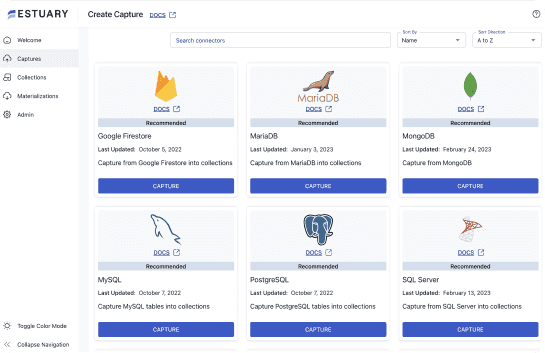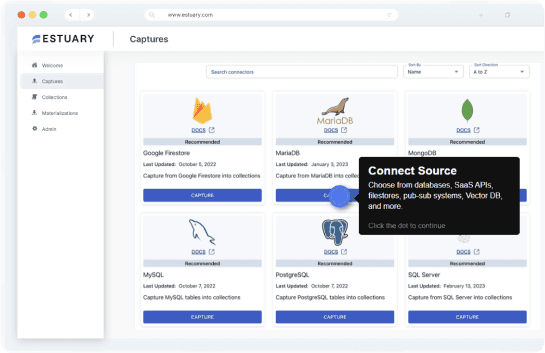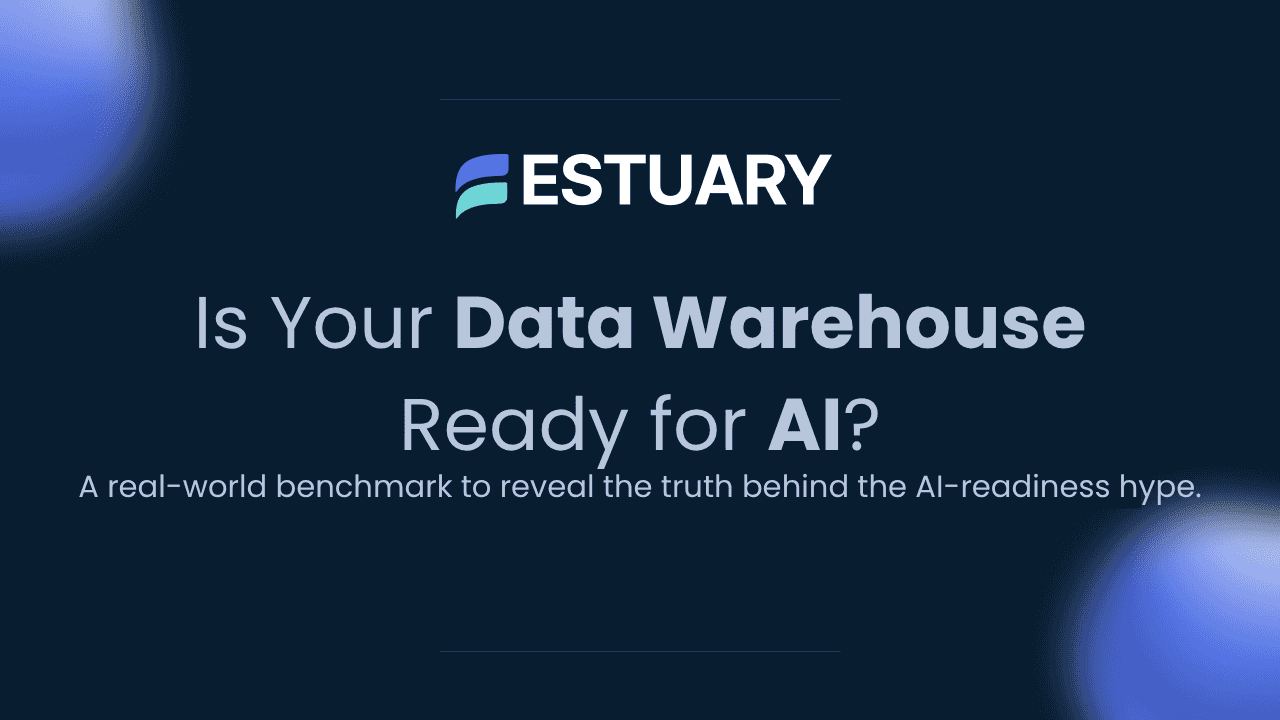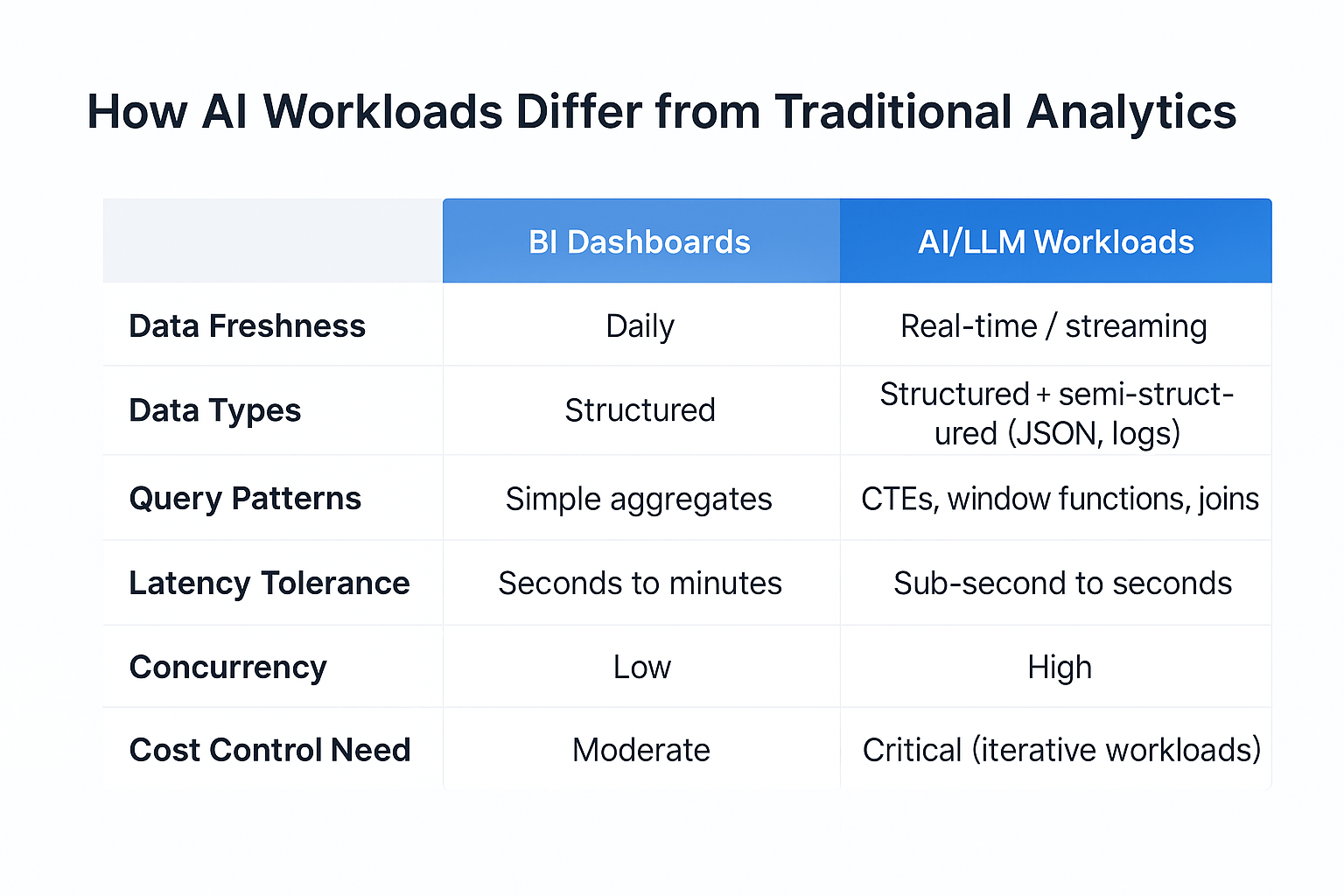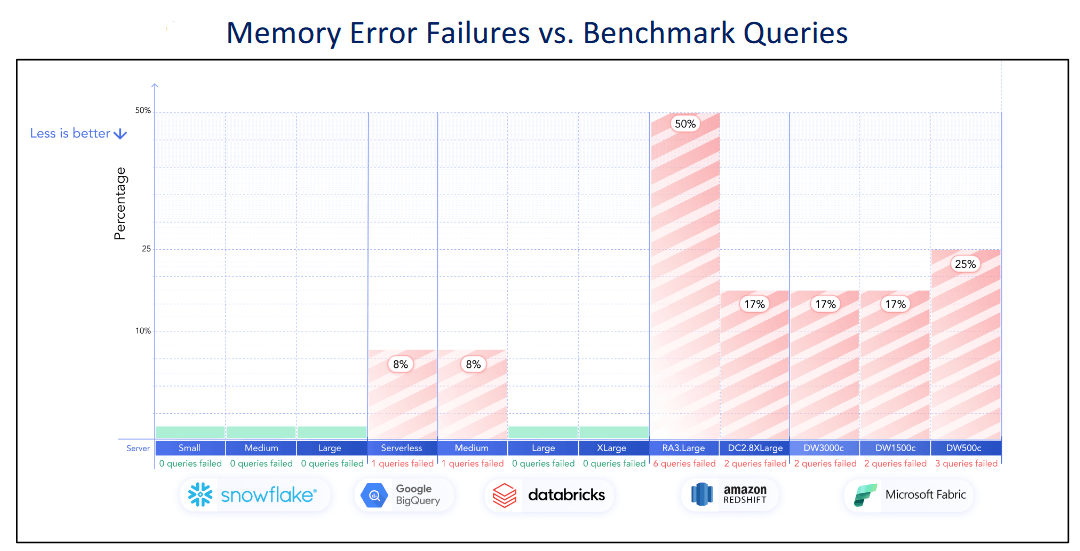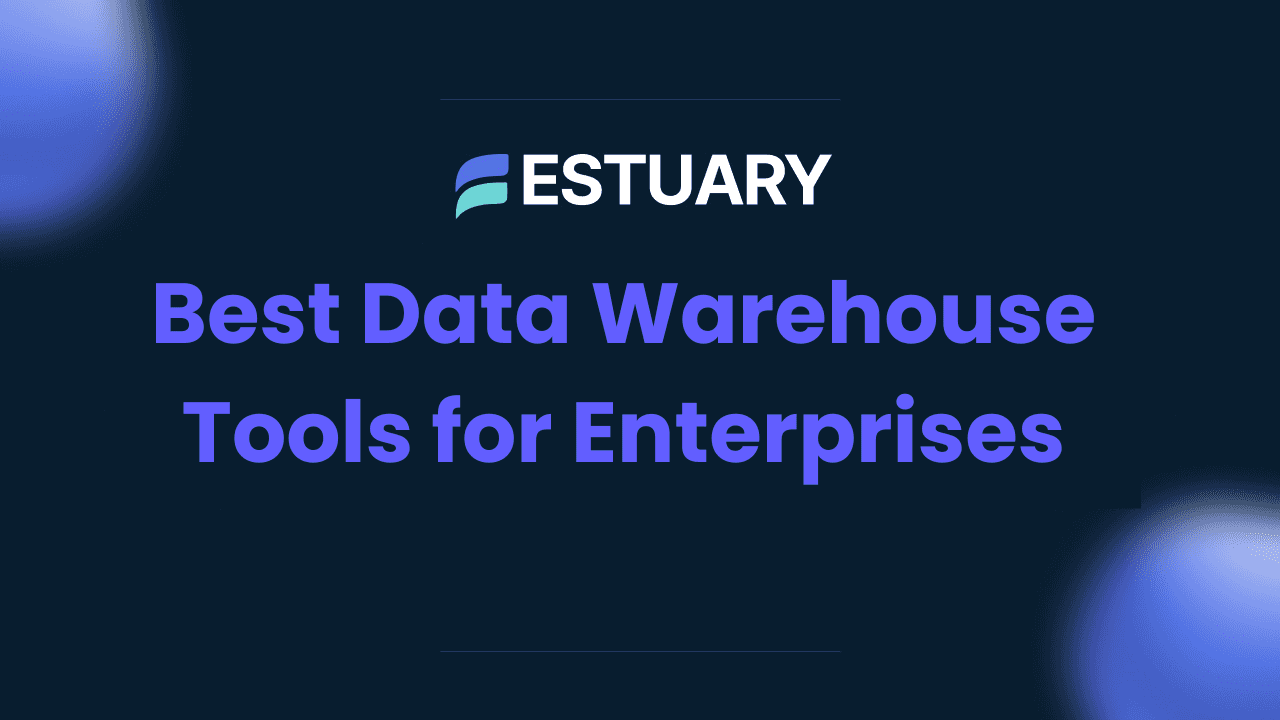
Intro: The AI-Data Warehouse Gap No One Talks About
Most companies are racing to adopt AI. Some are training models. Others are deploying LLM-powered apps. But nearly all of them are hitting the same bottleneck: their data warehouse.
The truth is, AI workloads break traditional data systems. The same infrastructure that powers dashboards and monthly reports often struggles under the pressure of AI pipelines, streaming ingestion, and rapid model iteration. And yet, when companies go shopping for a data warehouse, they’re still being sold based on legacy benchmarks that measure speed in a vacuum, not survivability at scale.
This is a problem. AI doesn’t wait. Your data infrastructure needs to deliver when queries pile up, when JSON payloads get messy, and when large volumes of data need to move in milliseconds. Not all warehouses are built for that. Some crumble. Some just cost a fortune to stay afloat.
So we put them to the test.
At Estuary, we ran a high-pressure benchmark on the five most widely adopted cloud data warehouses. The goal wasn’t just to find out who’s fast. We wanted to know: Which of these platforms can actually support AI workloads at scale? Which ones can handle complex queries, real-time ingestion, and heavy compute without falling over?
We tested real-world AI-style queries on over 1TB of data. The results were surprising. You can get the full benchmark report right here if you want to skip ahead.
The New Demands of AI Workloads
It’s easy to assume that if a data warehouse is fast, it’s good enough for AI. But performance alone doesn’t tell the whole story.
AI and LLM workloads come with an entirely new set of expectations. These aren’t just queries on clean tables. They’re long chains of processing, often working across structured and semi-structured data, running in parallel, and operating under tight latency windows. They’re far messier, more compute-heavy, and harder to optimize.
Here’s what that looks like in practice.
- Real-time or streaming ingestion: AI applications often depend on the freshest data available. Whether it’s fraud detection, personalization, or predictive ops, stale data creates stale outcomes. Warehouses that can’t handle high-throughput ingest or change data capture (CDC) will struggle to keep up.
- Semi-structured data: JSON blobs, event logs, and nested formats are common inputs for LLMs. Traditional warehouses weren’t built for this kind of data and often require flattening or transformation before it can be used, which adds friction, cost, and delay.
- Complex SQL and orchestration: AI-ready queries tend to include advanced SQL like window functions, recursive joins, CTE pipelines, or text processing. They’re not the kind of queries BI dashboards run. They push compute boundaries and reveal architectural weaknesses.
- Concurrency and throughput: AI workloads don’t run one query at a time. Multiple agents, models, or teams may be hitting the warehouse simultaneously. You need a system that scales horizontally without collapsing under pressure.
- Predictable cost control: If every vector search or RAG prompt costs a few dollars, you’ll burn through your cloud budget faster than your team can optimize it. AI workflows are iterative. That means your warehouse needs budget guardrails built-in.
During our benchmark, we modeled these exact demands, and let’s just say not every platform held up.
Some well-known data warehouses failed to complete key queries. Others racked up unexpected costs. One even broke under a common JSON operation used in LLM input preprocessing.
We’ll dive into how we built the test next. But if you're curious which platforms struggled and which ones thrived the full results are available in the report below.
How We Benchmarked for AI Readiness
To understand which data warehouses are truly built for AI, we had to go beyond synthetic tests and stock demos. We needed a realistic, hands-on benchmark that pushed each platform like a real data team would.
So we designed one from scratch.
We started with the industry-standard TPC-H SF1000 dataset, which weighs in at roughly 1TB. But we didn’t stop there. We extended it with semi-structured JSON fields to simulate the kind of hybrid data that AI teams work with every day. Think nested logs, unflattened events, and real-world inconsistencies.
Then we wrote 13 benchmark queries — not the typical SELECT AVG(*) examples. These queries were based on actual patterns used in AI pipelines. They included:
- Multi-layered CTEs
- Tokenization and text processing
- Ranking and lead-lag functions
- Joins across structured and semi-structured sources
- Monthly aggregations with time windows and filters
Every query was reviewed by engineers who build and maintain AI infrastructure. And just to raise the bar, we added one special test we called Query-F. It was designed to simulate a real AI workload at scale — chaining CTEs, subqueries, and heavy joins across JSON and tabular data. It broke some platforms. Literally.
Each warehouse was tested using the same conditions: no hyper-tuning, no pre-warmed caches, and default configurations. We wanted to see how each one performed out of the box, just like it would during a proof of concept or early-stage deployment.
And because cost matters just as much as speed, we logged billing data across 24-hour windows for every test. Some platforms looked fast on paper, until the invoice showed up.
We’ll reveal the high-level results next. But if you're the kind of person who wants to see the actual queries, cost breakdowns, and failure reports, the full benchmark includes everything — including our GitHub repo and exact testing setup.
The AI-Readiness Scorecard: Who’s Leading, Who’s Lagging
After running all 13 queries across five major data warehouse platforms, the results were… illuminating.
Some systems flew through the benchmarks with strong performance and stable costs. Others buckled under the weight of semi-structured data or crashed entirely on advanced workloads like Query-F. In some cases, warehouse pricing models made even successful runs financially unsustainable.
To help simplify the picture, we created an AI-Readiness Radar. It scores each platform across the factors that matter most for modern AI workflows:
- Compute robustness
- AI-centric features
- Ecosystem integration
- Documentation quality
- Ease of use
Here’s a quick snapshot:
Top Performers
- Databricks impressed with built-in Python notebooks, AI-native architecture, and flexibility in handling both structured and unstructured data. It wasn’t always the fastest, but it was consistent and resilient under pressure.
- Snowflake ranked high for stability, ecosystem depth, and scalability. While not purpose-built for AI, it handles heavy workloads well, especially when optimized with tagging and programmatic controls.
- BigQuery showed raw speed in many benchmarks, especially with serverless scaling. But without cost guardrails, it can be risky to run iterative or large-scale AI workloads over time.
The Strugglers
- Redshift suffered from memory errors, slow runtimes, and expensive compute that lacked auto-shutdown options. Its architecture simply isn’t aligned with AI demands in 2025.
- Microsoft Fabric had potential, especially in terms of documentation and tooling. But frequent memory failures and steep setup complexity held it back from being enterprise-AI ready.
Of course, these rankings only scratch the surface. Each platform had standout moments and surprising failures. Some handled JSON workloads beautifully, then choked on window functions. Others were cost-effective at low scale, but unpredictable at high concurrency.
We’ve detailed every query result, configuration, and score in the full benchmark report. If you’re choosing a platform to power LLMs or AI apps, it’s worth reviewing the data in full.
Platform-by-Platform Breakdown
If you’re evaluating platforms for AI and LLM workloads, here’s what stood out from our benchmark. These aren’t marketing claims — they’re field-tested results from real workloads at scale.
Databricks
The most AI-native platform in the group. Built-in notebooks, deep Python support, and tools like Mosaic AI make Databricks a natural fit for teams working on machine learning, RAG pipelines, or real-time inferencing. It handled complex SQL and semi-structured data well, even if it wasn’t always the fastest.
Ideal for: Teams prioritizing flexibility, native ML tooling, and open data formats.
Snowflake
Rock-solid across the board. Snowflake may not advertise itself as “AI-first,” but it handled the majority of workloads with stability, efficiency, and solid cost control. Features like query tagging, API-level controls, and ecosystem integrations give engineering teams a lot to work with.
Ideal for: Enterprise teams looking for performance, predictability, and mature infrastructure.
BigQuery
BigQuery surprised us with blistering speed, particularly on serverless compute. It handled heavy analytical workloads and JSON processing faster than most platforms. But there’s a catch: cost control is difficult. Without budget caps or workload-level limits, AI teams risk getting burned by surprise billing.
Ideal for: Fast-moving teams already in the Google ecosystem, with a strong handle on cost management.
Microsoft Fabric
Fabric shows promise, especially with its ETL engine and enterprise-grade integrations. But in practice, it failed multiple queries due to memory limitations and lacked the flexibility needed for modern AI pipelines. Setup was complex, and performance didn’t always match expectations.
Ideal for: Large enterprises with existing Azure investments — but not for agile AI teams.
Redshift
This was the most concerning result. Redshift frequently crashed, incurred high costs, and lacked features like autoscaling or autosuspend. Its architecture still ties storage to compute, which makes scaling painful. It simply isn’t designed for AI-driven workflows or modern concurrency needs.
Ideal for: Legacy AWS environments with minimal AI requirements. Everyone else should be cautious.
Each of these platforms has strengths. But when it comes to building AI-native infrastructure, the differences are significant — and sometimes surprising.
We’ve included complete query results, cost comparisons, and configuration notes for each platform in the full benchmark report.
If you’re serious about making the right call for your data strategy, this is worth reviewing in detail.
Choosing the Right Warehouse for Your AI Journey
There’s no one-size-fits-all answer. The “best” data warehouse depends on where your team is today, what kind of AI you’re building, and how fast you're scaling.
Here’s a simple way to think about it:
Startups or lean AI teams
If you’re just getting started or moving fast with a small team, go for a platform that gives you the most flexibility out of the box. You want native support for notebooks, real-time data ingest, and minimal setup time.
Databricks and BigQuery are both strong options here. Databricks offers deep AI-native tooling without requiring much infrastructure overhead. BigQuery’s speed is unbeatable if you can stay on top of costs.
Mid-market teams scaling production AI
If you’ve got pipelines running in production and cross-functional teams depending on AI insights, you need something stable, scalable, and cost-predictable.
Snowflake hits that balance well. It’s fast, deeply integrated with modern data stacks, and comes with the controls you’ll need as your AI workloads grow.
Enterprise organizations with complex security or compliance
For companies already deep into the Azure or AWS ecosystem, Microsoft Fabric or Redshift might feel like the “safe” choice, but the benchmark shows that both come with serious trade-offs.
If compliance drives your choice, take the time to test workloads early. AI performance isn’t just about integrations. It's about how compute holds up when stress-tested. You don’t want to find that out after the procurement cycle.
No matter where you fall, one thing is clear: the platforms that worked well a few years ago weren’t designed for the scale and complexity of today’s AI systems. Picking the right warehouse now will define how fast your team can build, experiment, and deliver AI-powered value.
That’s why we built this benchmark — to give teams like yours a clear, realistic view of what actually works.
And if you want the details, the full report is just a click away.
Final Thoughts: Future-Proofing Your AI Infrastructure
Data warehouses used to be a place to store reports. Now, they’re expected to power everything from LLM workflows to real-time personalization, fraud detection, and next-gen analytics.
That shift comes with new risks.
If your warehouse can’t handle the complexity and concurrency of modern AI workloads, your team will feel it. You’ll lose time tuning queries. Burn budget on slow pipelines. Or worse, delay critical projects because the infrastructure wasn’t built to scale the way your models do.
We’ve seen it happen. That’s why we created this benchmark — not to crown a winner, but to give data leaders real clarity before committing to platforms that may not keep up.
If you’re serious about building for the next wave of AI, your data stack needs to evolve. This report is a step toward that decision — one based on actual engineering outcomes, not slide decks.
The full report includes all 13 benchmark queries, runtime and cost charts, memory failure analysis, and detailed platform-by-platform breakdowns.
Download it now and move forward with confidence
FAQs
Which data warehouses performed best for AI workloads in the Estuary benchmark?
What was Query-F in the benchmark report?
Is BigQuery good for AI and LLM workloads?
How can I choose the right data warehouse for AI workloads?

About the author
Dani is a data professional with a rich background in data engineering and real-time data platforms. At Estuary, Daniel focuses on promoting cutting-edge streaming solutions, helping to bridge the gap between technical innovation and developer adoption. With deep expertise in cloud-native and streaming technologies, Dani has successfully supported startups and enterprises in building robust data solutions.

